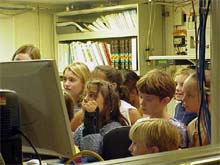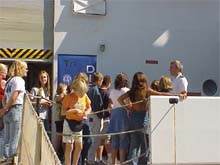
Scientist Laura Cottrell explains how the CTD rosette works to the kids at the Hudson Canyon Ocean Exploration Port Call Event. Laura also highlighted the areas on the map where water samples were collected. Click image for larger view.
Port Call Event: New York City-Intrepid Museum
September 17, 2002
Lisa M. Weiss, Watershed Coordinator
Jacques Cousteau National Estuarine Research Reserve
We docked at the Intrepid Museum in the Port of New York City on Sunday September 15th, after three weeks of mapping the Hudson Submarine Canyon. As the skyline of New York City emerged from the fog, we were greeted by one-person sailing vessels and news helicopters.
On the morning of Tuesday September 17th, we commenced the Port Call and Open House for the Ronald H. Brown, the Hudson Canyon Exploration and the Ocean Exploration Program. The morning began with a VIP breakfast aboard the Ron Brown at 8am which was followed by a media event at 9am. School groups from the New York and New Jersey area began arriving around 10am. Students that attended ranged from 5th graders up to high school.

Dr. Peter Rona explains to the students the importance of ocean explorations and seafloor mapping. He began with a global overview and narrowed his focus to the mapping in the Hudson Canyon. Click image for larger view.
The ship’s officers and captain ran tours of the Ron Brown. The tours began at the gangway with an overview about the ship and its operations. The students then met Dr. Peter Rona, who stressed the importance of ocean explorations and ocean mapping. He explained the lack of global mapping and the importance of a well-done map for use by other explorers in the future. He explained the reasons behind why the Hudson canyon was chosen and the ways in which the new data will be used in future ocean explorations and exciting discoveries.
After Dr. Rona’s overview, the students were led into the computer lab, where they watched a virtual fly-through of the Hudson Canyon. (Imagine seeing the Canyon like you were a bobsled racer for the Olympics!) Tammie Middleton, a scientist from the U.S. Geological Survey, used the mapping data to vertically exaggerate the changes in seafloor topography. She then programmed a simulation of a trip through the Canyon for the students to display the structure of this ancient submarine canyon system.

Students watch a virtual Hudson Canyon fly-over simulation put together by scientist Tammie Middleton. This fly-over was completed from the data collected from our 2002 Hudson Canyon Exploration. Click image for larger view.
The students then met Laura Cottrell, the scientist from SUNY Stony Brook who had collected the water column samples using the CTD rosette system during the expedition. She explained the areas in which water samples were collected, and how the rosette was used in the collection process. She also demonstrated how water was transferred from the sampler to the sample bottles and how she will be processing the samples once they are returned to the Stony Brook lab. Laura explained the importance behind collecting the water samples, and how these samples will be used for future determinations of energy resources and future explorations.

Ron Brown’s Officer John Steegar begins a tour of the ship at the Port Call in New York City. Students heard about the science behind the expedition and received a tour of the ship. Click image for larger view.
The tour groups then were escorted around the Ron Brown, and saw areas such as the Navigational Bridge, the staterooms, the galley, the lounge, and the weight room. The tours also saw some of the additional scientific equipment that was loaded aboard the Ron Brown for future projects. Students saw what it was like to live aboard ship for a period of time, and asked questions about NOAA and its research.
The port call event provided an opportunity for the science team to explain the importance of the research, for the ship’s officers to explain the operations of the ship and for the Office of Ocean Exploration to highlight the value of its exploration program. Bringing science to life for students is the best way to get them interested in the wonders of scientific explorations, as well as making science fun and exciting.
Sign up for the Ocean Explorer E-mail Update List.























